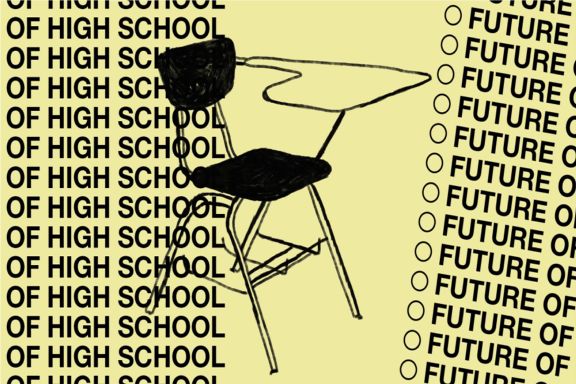The History of the Future of High School
The problem with American secondary education is not that students haven’t learned the “right skills,” as the Betsy DeVoses of the world would have you believe.
This story appears in VICE Magazine's Power and Privilege Issue. Click HEREto subscribe.
High school is broken in America. Its buildings and classes are old and stodgy. As an institution, it’s unchanging, built to crank out factory workers and thus unsuited for our modern, high-tech era.
That’s the convenient fiction repeated by business-minded politicians and philanthropists for some time now. Consider what the US secretary of education, Betsy DeVos, told students in Wyoming last year: “For far too many kids,” DeVos said, “this year’s first day back to school looks and feels a lot like last year’s first day back to school. And the year before that. And the generation before that. And the generation before that.” Later, while visiting a charter school in Florida, DeVos again said as much: “Far too many schools have been stuck in a mode that is basically approaching things that have been done very similarly to 100 years ago, and the world today is much different.”
It’s a popular narrative reflecting the very real fears held by so many young people today when it comes to economic instability, inequality, and their future prospects in the labor market. The thing of it is, it’s just not true.
When folks like DeVos make the inaccurate claim that schools haven’t changed in a century, they often invoke the phrase “factory-model schooling,” implying that schools—the buildings, the curriculum, the practices—were established to prepare students for manufacturing work. America’s first high school opened in 1635, and taught religion and the classics to the sons of wealthy elites. High schools in the late 1800s and early 1900s in the US were likewise not designed to prepare students for work in factories, despite the pervasiveness of that “factory model” myth. Rather, most of these early learning institutions served academically talented students whose parents could afford to have their child pursue secondary education. That is, they could get by without their teenager working. Only a fraction of kids attended high school in those days, and an even smaller fraction of those students went on to university, in part because most professions did not require college degrees.
As the historians David Tyack and Larry Cuban wrote in their 1995 history of school reform, Tinkering Toward Utopia, just one in every ten teens age 14 to 17 was enrolled in high school in 1900. By 1940, that number was up to seven in ten; by 1980, nine in ten. The percentage of kids enrolled in high school has continued to grow in the decades since Tinkering was published, as have graduation rates (8 percent in 1900, 51 percent in 1940, and about 83 percent today). These shifting demographics have transformed what schools do and are expected to do. A century ago, students of color were largely denied equal access to educational opportunities, for example, and special education as we know it didn’t exist. And though it’s not always the way it works out in practice, public high schools are now required to serve all students, and curriculum modifications along the way reflect that.
To meet the needs of these incoming students, schools started offering an Continue reading: The History of the Future of High School - VICE



